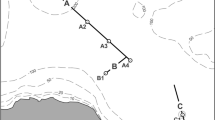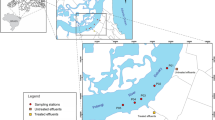Abstract
Severe deterioration of water quality occurs during jute retting in ponds, canals, floodplain lakes, and other inland water bodies in the rural areas of West Bengal in India. Attempts were made to evaluate changes in the physicochemical parameters of water caused by jute retting, and their impact on the survival of two species of freshwater fish (Labeo rohita and Hypophthalmicthys molitrix) and two species of freshwater invertebrate (Daphnia magna, a Cladocera, and Branchiura sowerbyi, an Oligochaeta). Results showed that jute retting in a pond for 30 days resulted in a sharp increase in the BOD (>1,000 times) and COD (>25 times) of the water, along with a sharp decrease in dissolved oxygen (DO). Free CO2, total ammonia, and nitrate nitrogen also increased (three to five times) in water as a result of jute retting. Ninety-six-hour static bioassays performed in the laboratory with different dilutions of jute-retting water (JRW) revealed that D. magna and B. sowerbyi were not susceptible to even the raw JRW whereas fingerlings of both species of fish were highly susceptible, L. rohita being more sensitive (96 h LC50 37.55% JRW) than H. molitrix (96 h LC50 57.54% JRW). Mortality of fish was significantly correlated with the percentage of JRW.



Similar content being viewed by others
References
APHA (American Public Health Association) (1995) Standard methods for the examination of water and wastewater, 19th edn. APHA, Washington DC
Asaduzzaman M, Abdullah ABM (1998) Impact of retting and other post harvest processes on quality of jute fibre. Proceedings of international seminar on jute and allied fibres—changing global scenario. February 5–6, 1998, Calcutta, pp 109–113
Banerjee S, Dastidar MG (2005) Use of jute processing wastes for treatment of wastewater contaminated with dye and other organics. Bioresour Technol 96:1919–1928
Banik A, Sen M, Sen SP (1993) Methane emission from jute retting tanks. Ecol Eng 2:73–79
Basak MK, Bhaduri SK, Banik S, Kundu SK, Sardar D (1998) Some aspects of biochemical changes associated with retting of green jute plants. Proceedings of international seminar on jute and allied fibres—changing global scenario, February 5–6,1998, Calcutta, pp 105–108
Beamish FWH, Tandler DA (1990) Ambient ammonia diet and growth in lake trout. Aquat Toxicol 17:155–166
Bhaumik U, Mittal IC, Das P, Paria T (2006) Structure of benthic fauna in two floodplain wetland ecosystems of West Bengal. J Inland Fish Soc India 38:31–37
Bhunia F, Saha NC, Kaviraj A (2003) Effects of aniline—an aromatic amine to some freshwater organisms. Ecotoxicology 12:397–404
Das BK, Kaviraj A (1994) Individual and interactive lethal toxicity of cadmium, potassium permanganate and cobalt chloride to fish, worm and plankton. Geobios 21:223–227
FAO (Food and Agriculture organization) (1998) Improved retting and extraction of jute, project findings and recommendations. Terminal Report, AG: GCP/RAS/122/IJO, FAO/Govt. Cooperative Programme, FAO, Rome
Finney DJ (1971) Probit analysis. Cambridge University Press, London, UK
Haque MS, Zakaria A, Adhir KB, Firoza A (2003) Identification of Micrococcus sp. responsible for the acceleration of jute retting. Pakistan J Biol Sci 6:686–687
Kaviraj A, Bhunia F, Saha NC (2004) Toxicity of methanol to fish, crustacean, oligochaete worm and aquatic ecosystem. Int J Toxicol 23:55–63
Khan RA (2002) The ecology and faunal diversity of two floodplain Ox-Bow lakes of south-eastern West Bengal. Rec Zoolog Surv India 195:1–57
Knoph MB (1992) Acute toxicity of ammonia for Atlantic salmon (Salmo salar) parr. Comp Biochem Physiol C 101:275–282
Kumar A (1999) Pen culture prospects in reservoirs and beels: success and constraints with particular reference to Akaipur beel of 24 Parganas, West Bengal. J Freshwater Biol 11:47–52
Mondal DK, Das BK, Kaviraj A (2006) Ichthyofaunal diversity and aquaculture potential of some floodplain wetlands in the district of North 24 Paraganas, West Bengal. J Inland Fish Soc India 38:23–27
Winner BJ (1971) Statistical principles in experimental design, 2nd ed. McGraw–Hill, New York
Acknowledgement
The authors are thankful to the Head, Department of Zoology, University of Kalyani, for providing the facilities necessary for this research.
Author information
Authors and Affiliations
Corresponding author
Rights and permissions
About this article
Cite this article
Mondal, D.K., Kaviraj, A. Ecotoxicological effects of jute retting on the survival of two freshwater fish and two invertebrates. Ecotoxicology 17, 207–211 (2008). https://doi.org/10.1007/s10646-007-0185-6
Received:
Accepted:
Published:
Issue Date:
DOI: https://doi.org/10.1007/s10646-007-0185-6




